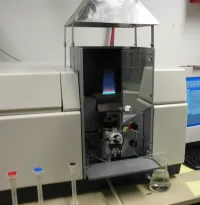Atom absorption spectral photometer
AAS FL 5, Fa. Analytic-Jena (radiation spectrometer using alternating light method)
Principle: A sample of material is sucked up in a dissolved form, atomized into fine droplets (aerosol), brought into the flame and evaporated. Salt particles in the material melt and dissociate to metal ions. Through the heat energy of the flame, the outside valence electrons are excited, and are brought up to a higher energetic level (energy in the form of element-specific radiation can be absorbed=absorption). At relapse back to the original state, the previously induced energy becomes light energy, through which the atoms emit their element-specific spectrum (emission). This is then dispersed in the spectrometer, and subsequently analyzed.
The alkali metals can be measured in either emission or absorption mode.
The foundation for the evaluation of the quantitative analysis on the AAS is the Lambert Beer Law: the absorbance A of the irradiated layer thickness d and the concentration c of the substance is proportional. This law applies only to monochromatic radiation, and dilute solutions. The linearity of the calibration curve is given for low concentration measurements. At higher concentrations, curvature in the calibration curve is possible.
Flame type: Acetylene/air (approx. 2500 K) or Acetylene/nitrous oxide (approx. 3000 K - 3500 K)
Radiation source: Element-specific hollow cathode lamps
Determinable elements: Principally all elements in the wavelength range between 852.1 nm (Cs) and 193.7 nm (As).
Burner type: Slot burners (50 mm and 100 mm)
Monochromator: Optical grid
Detector: Photomultiplier
Absorption Spectrometer: Excitation of the atoms through optical radiation, defined energy intake of the radiation of the atoms.
Emissions Spectrometer: Excitation of the atoms occurs through thermal or electrical energy, energy exchange in the form of radiation of the atoms.
